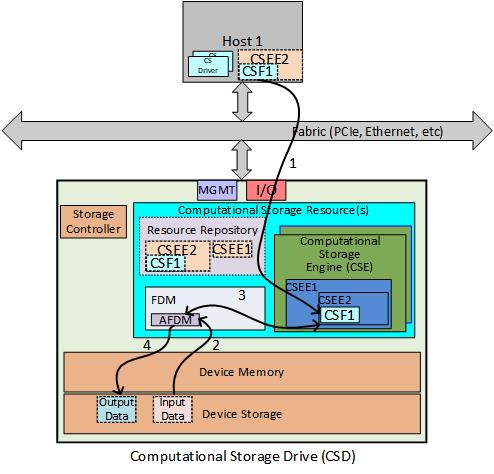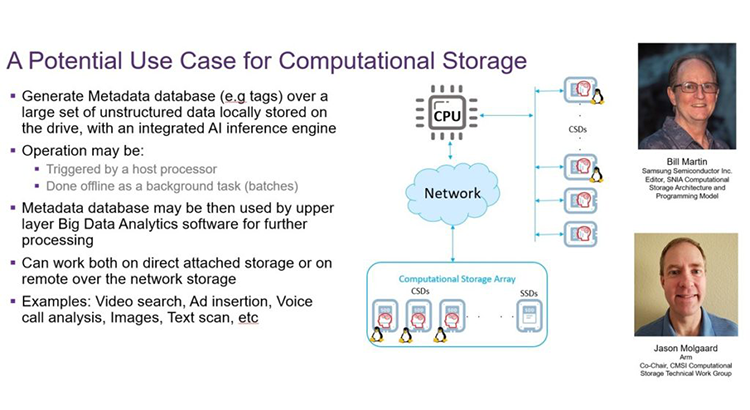Our recent SNIA Compute, Memory, and Storage Initiative (CMSI) webcast, Computational Storage – Driving Success, Driving Standards, explained the key elements of the SNIA Computational Storage Architecture and Programming Model and the SNIA Computational Storage API . If you missed the live event, you can watch on-demand and view the presentation slides. Our audience asked a number of questions, and Bill Martin, Editor of the Model, and Jason Molgaard, Co-Chair of the SNIA Computational Storage Technical Work Group, teamed up to answer them.
What’s being done in SNIA to implement data protection (e.g. RAID) and CSDs? Can data be written/striped to CSDs in such a way that it can be computed on within the drive?
Bill Martin: The challenges of computation on a RAID system are outside the scope of the Computational Storage Architecture and Programming Model. The Model does not address data protection in that it does not specify how data is written nor how computation is done on the data. Section 3 of the Model discusses the Computational Storage Array (CSA), a storage array that is able to execute one or more Computational Storage Functions (CSFs). As a storage array, a CSA contains control software, which provides virtualization to storage services, storage devices, and Computational Storage Resources for the purpose of aggregating, hiding complexity, or adding new capabilities to lower level storage resources. The Computational Storage Resources in the CSA may be centrally located or distributed across CSDs/CSPs within the array.
When will Version 1.0 of the Computational Storage Architecture and Programming Model be available and when is operating system support expected?
Bill Martin: We expect Version 1.0 of the model to be available Q2 2022. The Model is agnostic with regard to operating systems, but we anticipate a publicly available API library for Computational Storage over NVMe.
Will Computational Storage library support CXL accelerators as well? How is the collaboration between these two technology consortiums?
Jason Molgaard: The Computational Storage Architecture and Programming Model is agnostic to the device interface protocol. Computational Storage can work with CXL. SNIA currently has an alliance agreement in place with the CXL Consortium and will interface with that group to help enable the CXL interface with Computational Storage. We anticipate there will be technical work to develop a computational storage library utilizing the CS API that will support CXL in the future.
System memory is required for PCIe/NVMe SSD. How does computational storage bypass system memory?
Bill Martin: The computational storage architecture relies on computation using memory that is local to the Computational Storage Device (CSx).Section B.2.4 of the Model describes the topic of Function Data Memory (FDM) on the CSx and the movement of data from media to FDM and back. Note that a device does not need to access system memory for computation – only to read and write data. Figure B.2.8 from the Model illustrates CSx usage.

Is this CS API Library vendor specific, or is this a generic library which could also be provided for example by an operating system vendor?
Bill Martin: The Computational Storage API is not a library, it is a generic interface definition. It describes the software application interface definitions for a Computational Storage device (CSx).There will be a generic library for a given protocol layer, but there may also be vendor specific additions to that generic library for vendor specific CSx enhancements beyond the standard protocol definition.
Are there additional use cases out there? Where could I see them and get more information?
Jason Molgaard: Section B.2.5 of the Computational Storage Architecture and Programming Model provides an example of application deployment. The API specification will have a library that could be used and/or modified for a specific device. If the CSx does not support everything in NVMe, an individual could write a vendor specific library that supports some host activity.
There are a lot of acronyms and terms used in the discussion. Is there a place where they are defined?
Jason Molgaard: Besides the Model and the API, which provide the definitive definition of the terms and acronyms, there are some great resources. Recent presentations at the SNIA Storage Developer Conference on Computational Storage Moving Forward with an Architecture and API and Computational Storage APIs provide a broad view of how the specifications affect the growing industry computational storage efforts. Additional videos and presentations are available in the SNIA Educational Library, search for “Computational Storage”.
